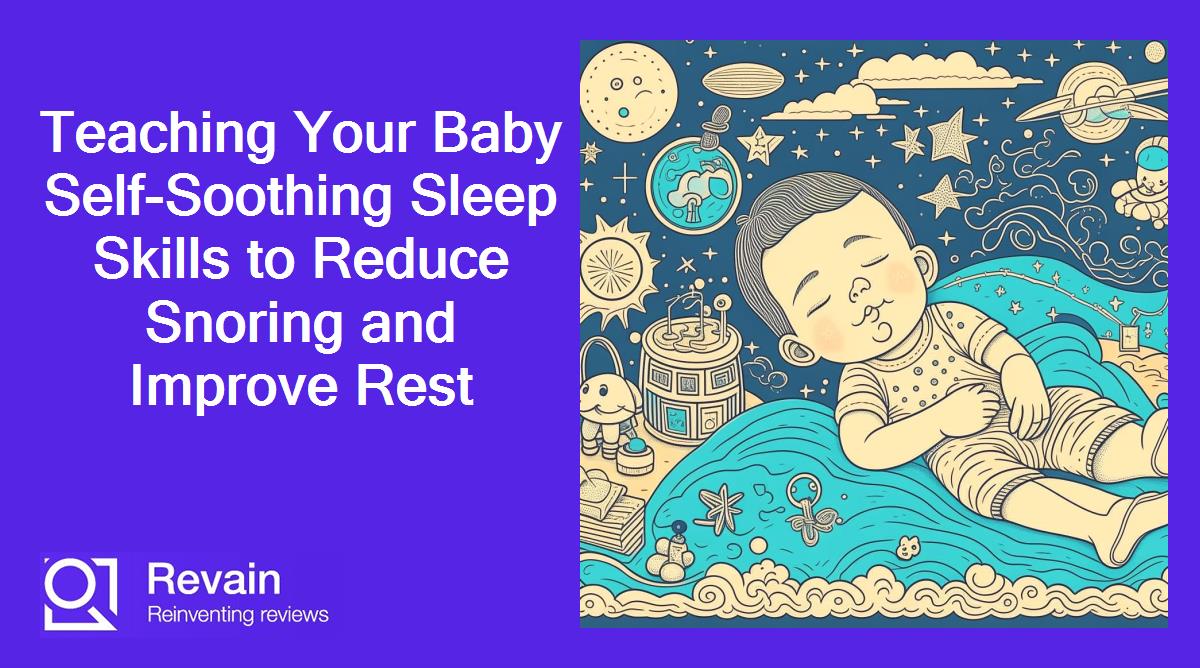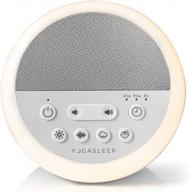Trouble Falling Asleep? Tips for Better Baby Sleep
It's no secret that sleep is incredibly important for babies. Quality sleep supports healthy development and growth. However, many parents struggle with getting their little ones to fall and stay asleep. There are several tips and techniques you can try to help your baby sleep better.
Establish a Bedtime Routine
Babies thrive on consistency and scheduling. Try to establish a calming bedtime routine that you stick to every night. Things like a warm bath, putting on pajamas, reading books, singing lullabies, and rocking can cue your baby that it's time to sleep.
Make the Room Sleep Friendly
- Use blackout curtains or blinds to make sure the room is dark
- Try using white noise from a sound machine to drown out disruptive household noises
- Keep the room a comfortable temperature - between 65-70°F
- Make sure the crib mattress fits snugly and use tight fitting sheets
Similar products
Encourage Self-Soothing
While rocking and feeding your baby to sleep is fine early on, you'll eventually want to teach them to self-soothe. Put your drowsy baby down while they are still awake. You can offer reassurance by talking softly or putting your hand on them.
Watch for Sleep Cues
Look for signs your baby is ready for sleep. These include:
- Rubbing eyes
- Pulling ears
- Yawning
- Fussiness
- Decreased activity
Start the bedtime routine as soon as you notice sleep cues. Don't wait until baby is overtired.
Keep Naps on Schedule
Make sure your baby isn't sleeping too much during the day, which can impact nighttime sleep. Aim for a consistent daily nap schedule. For example:
| Age | Recommended Daily Nap Hours |
|---|---|
| Newborn | 14-17 hours |
| 2-4 months | 12-15 hours |
| 4-12 months | 11-14 hours |
Another interesting products
Be Patient
Every baby is different. It can take time to find the right sleep training techniques. Stay consistent and remember that phases of poor sleep won't last forever. Speak to your pediatrician if you have ongoing concerns.
Top products in 😴 Sleep & Snoring
Common Causes of Infant Snoring and Solutions
It's normal for babies to make some noises while sleeping. However, loud or frequent snoring may be a sign of an underlying issue. Here are some of the most common causes of infant snoring and potential solutions.
Congestion
A stuffy or runny nose from a cold can cause noisy breathing and snoring. Try using a humidifier or saline drops/spray to loosen mucus. Elevating baby's head while sleeping can also help with congestion.
Allergies
Allergies to things like dust mites or pet dander can contribute to snoring. Reduce allergen exposure by:
- Washing bedding frequently in hot water
- Using a HEPA air purifier
- Keeping pets out of baby's room
Talk to your doctor about safe antihistamines or nasal steroids if needed.
Enlarged Adenoids/Tonsils
Overgrown adenoids or tonsils narrow the airway. Other signs include:
- Noisy breathing
- Mouth breathing
- Frequent ear infections
See an ENT specialist to determine if removal is recommended.
Sleep Apnea
This serious disorder involves paused breathing during sleep. In addition to snoring, look for:
- Gasping/choking at night
- Restless sleep
- Difficulty staying asleep
- Daytime sleepiness
Sleep studies can diagnose sleep apnea. Treatment may include CPAP or supplemental oxygen.
Gastroesophageal Reflux (GERD)
When stomach acid backs up into the throat, it can irritate the airways and lead to snoring. Other signs of reflux include:
- Spitting up/vomiting
- Irritability during/after feeding
- Trouble gaining weight
- Fussiness when lying flat
Lifestyle changes and medication can help treat reflux-related snoring.
Birth Defects
Rare conditions like a cleft palate or small lower jaw can narrow the airway. Consult a pediatrician if such physical abnormalities are present.
When to Seek Help
Talk to your doctor if snoring is frequent or disruptive to sleep. Together you can get to the root cause and implement solutions for more restful nights.
Creating a Soothing Sleep Routine for Your Little One
Establishing a consistent, relaxing bedtime routine is key to helping your baby wind down and transition to sleep. Here are some tips for creating a bedtime schedule that will have your little one snoozing in no time.
Pick a Consistent Time
Aim to start the bedtime routine at roughly the same time each evening. Keeping a consistent schedule will help regulate your baby's internal clock.
Bath Time
A warm (not hot!) bath has a calming effect. The drop in body temperature after getting out of the bath also triggers sleepiness. Keep baths brief for infants under 6 months.
Massage
A gentle massage with lotion helps soothe your baby after their bath. Focus on head, arms, legs, back and feet.
Pajamas and Swaddle
Putting on pajamas signals sleep is coming. Swaddling also helps a newborn feel comforted and secure. Use a thin blanket in warm months.
Dim the Lights
Bright lights can stimulate your baby. Keep lighting low, drawn the curtains, and turn off electronics.
Read a Book
Reading a story in a quiet voice is both bonding time and a relaxing activity before bed.
Rock, Sing, Cuddle
Other soothing techniques include:
- Rocking gently in a chair or while standing
- Singing lullabies
- Cuddling
White Noise
Sounds like a fan, air filter, or white noise machine can help drown out disruptive household noises to create a restful sleep environment.
Put Down Drowsy But Awake
When your baby is drowsy but still awake, put them down in their crib. This helps them learn to self-soothe and fall asleep independently.
Be Consistent
It may take a few weeks for your baby to get used to the routine. Stick with it and keep bedtime at around the same time 7 days a week.
Following a calming routine like this signals to your little one's brain and body that it's time wind down for a good night's sleep.
Baby Not Sleeping? How to Handle Sleep Regressions
It can be frustrating and exhausting when your baby who was previously sleeping well suddenly starts having sleep problems. These periods of disturbed sleep are referred to as sleep regressions. They are temporary and common in the first year.
When Sleep Regressions Occur
Some common ages when babies experience sleep regressions include:
- 4 months
- 6 months
- 8 months
- 12 months
Sleep regressions coincide with major developmental milestones that disrupt your baby's sleeping patterns.
Signs of a Sleep Regression
- Awakening frequently at night
- Having difficulty falling asleep
- Waking up early
- Taking short naps
- Seeming overtired
Causes of Sleep Regressions
Some of the factors that lead to sleep regressions include:
- Mental leaps - learning new skills affects sleep cycles
- Separation anxiety - baby fears being apart from main caregiver
- Physical milestones - moving, standing, walking disrupt sleep
- Teething pain - sore gums keep baby awake
- Illness - congestion, fever, ear infections interfere with sleep
Handling Sleep Regressions
- Stick to consistent nap and bedtime schedules
- Maintain bedtime routines to signal sleep time
- Make the room dark, cool, and quiet
- Increase daytime feedings to reduce night wakings
- Use white noise to dull disruptive sounds
- Offer support through extra comforting and checks
Don't Start New Habits
Try not to nurse or rock your baby to sleep if you weren't doing this previously. Starting new habits could extend the regression period.
Have Patience
Regressions can be stressful but they are temporary and developmentally appropriate. Stay consistent and both you and your baby will sleep better again soon!
Getting Your Child to Sleep Through the Night
Many parents long for the day their child will sleep through the night. While every baby is different, there are things you can do to help encourage longer nighttime sleep as your child grows.
Establish a Bedtime Routine
A consistent, peaceful bedtime routine signals to your child that it's time to wind down for sleep. This can include activities like:
- Bath
- Brush teeth
- Put on pajamas
- Read books
- Sing lullabies
- Cuddle
Set an Early Bedtime
Putting your child to bed earlier gives them a better chance of sleeping later into the morning. An appropriate bedtime depends on age:
- Newborns: between 7-8 pm
- 6 months: between 6-8 pm
- 1 year: between 6-7 pm
- 2 years: between 7-8 pm
Encourage Self-Soothing
Help your child learn to fall asleep independently by putting them down drowsy but awake. You can offer reassurance by verbally soothing or rubbing their back.
Manage the Sleep Environment
An optimal sleep environment includes:
- Cool, dark room
- Comfortable crib and mattress
- Sleep sack instead of loose blankets
- White noise machine to block disruptive sounds
Get on a Schedule
Consistent nap and bedtimes help regulate the body's clock. Stick to a daily routine for naps and nighttime.
Solidify the Schedule
Once your child can go through the night without feeds, stick to the schedule. Avoid responding too quickly to fusses which can reinforce waking.
Limit Night Feedings
Gradually reduce night feeds by pushing the time back by 15 minutes each night. Increase daytime intake to reduce night hunger.
With consistency, patience, and developmentally appropriate strategies, your child can learn to sleep for longer stretches at night.
Baby Sleep Safety - Reducing SIDS Risk
Ensuring safe sleep practices is crucial to reducing your baby's risk of sudden infant death syndrome (SIDS). Here are some tips to create the safest possible sleep environment.
Sleep Baby on Their Back
Placing baby on their back (supine position) for every sleep is the #1 way to reduce SIDS risk. Avoid side or stomach sleeping.
Use a Firm Mattress
Use a firm, flat mattress covered by a tight fitting crib sheet. Soft mattresses and bedding increase suffocation risk.
No Loose Bedding
Keep the crib free of any loose blankets, pillows, crib bumpers, or stuffed animals.
Room Share, Don't Bed Share
Baby should sleep in their own crib or bassinet in the parent's room for at least the first 6 months.
Avoid Overheating
Dress baby lightly for sleep and maintain room temperature between 65-70°F to prevent overheating.
Consider a Pacifier
Studies show pacifiers may reduce SIDS risk. Offer one at nap time and bedtime once breastfeeding is established.
Immunize On Schedule
Make sure baby receives recommended vaccines on time, especially DTaP and flu shot in winter.
Don't Smoke or Allow Smoke Exposure
Do not smoke or allow secondhand smoke around baby. Smoke exposure increases SIDS risk.
Breastfeed When Able
Breastfeeding provides immunity benefits. Nurse as long as you are able.
Supervise Tummy Time
Always supervise baby during tummy time play while awake. Do not allow baby to sleep on stomach.
Following safe sleep guidelines and asking others to do the same gives your baby the best protection against SIDS.
Teaching Your Baby to Self Soothe and Fall Asleep
One of the most important sleep skills your baby can learn is how to self soothe and fall asleep on their own. With patience and consistency, you can help teach this skill.
Put Baby Down Drowsy But Awake
Start the process by putting your sleepy (but still awake) baby down in the crib at bedtime. This allows them to learn to drift off on their own.
Establish a Calming Routine
Follow the same relaxing routine before each nap and bedtime. This signals sleep is coming. Activities may include:
- Bath
- Massage
- Rocking
- Lullabies
- Reading
Allow Some Fussing
Your baby may fuss or cry out when you first put them down. Allow limited fussing before responding. Rushing in too soon can hinder self-soothing skills.
Periodically Reassure
If crying escalates, go in periodically to reassure baby with gentle touches and soothing words. But avoid picking up or rocking to sleep.
Utilize Sleep Cues
Look for signs of sleepiness like rubbing eyes or yawning. Start the bedtime routine before baby gets overtired.
Keep Things Boring
Make sure the sleep space is dark, cool, and distraction-free. Avoid prolonged eye contact, talking, or toys in the crib.
Consider a Security Object
Introduce a lovey or security blanket to provide comfort. It gives baby something to touch while self-soothing.
Stick With It
Self-soothing is a process. Your consistency and commitment will help baby develop this key skill over time.
With your support and encouragement, your little one will drift off to dreamland on their own.
How Amazon Prime Benefits "Sleep & Snoring" Buyers
Amazon Prime offers a number of benefits that can be very useful for regular buyers of sleep and snoring products.
Free Two-Day Shipping
Amazon Prime members get free two-day shipping on eligible items. This means you can quickly get sleep essentials like white noise machines, bedding, and anti-snoring aids delivered right to your door.
No more waiting around for weeks or paying exorbitant shipping fees. Prime makes reordering supplies fast and convenient.
Free Release-Date Delivery
You can also get free release-date delivery on eligible pre-orders. This ensures that hot new sleep products will arrive on your doorstep on launch day.
Try Before You Buy
Amazon Prime includes a "Try Before You Buy" service that lets you try on eligible clothes, shoes, and accessories for seven days before purchasing. This is extremely useful for comfortably testing out products like sleep masks, pillows, and slippers.
Access to Exclusive Deals
Prime members get exclusive access to special deals and discounts. You can save big on select sleep items like sound machines, humidifiers, and baby monitors.
Streaming Entertainment
Unlimited streaming of movies, TV shows, and music via Prime Video and Amazon Music can help lull you and baby to sleep. There are even customized children's content options.
Overall, a Prime membership provides significant benefits for regular buyers of sleep and snoring aids. The shipping perks, try before you buy service, special deals, and entertainment options make it a worthwhile upgrade.
Sleep Solutions For Babies And Children
Sleep is essential for the growth and development of babies and children. However, many parents struggle with getting their little ones to sleep through the night. Here are some sleep solutions for babies and children:
For babies 6 to 12 months old:
For newborns, babies, and toddlers:
For parents:
Remember, every baby is different, and what works for one may not work for another. It's important to find a sleep solution that works for you and your family.
How To Establish A Consistent Sleep Schedule For Babies And Children?
Establishing a consistent sleep schedule is important for babies and children to develop healthy sleep habits. Here are some tips to help establish a consistent sleep schedule for babies and children:
- Maintain a regular daytime and bedtime sleep schedule as much as possible.
- Follow a calming bedtime routine.
- Put your baby to bed drowsy, but still awake.
- Create a sleep-conducive environment (such as a dark, quiet room).
- Comfort your baby when he or she wakes up, but avoid picking him or her up.
- Encourage your baby to self-soothe.
- Decide on an appropriate bedtime.
- Start a positive bedtime routine (such as a warm bath and reading a book).
- Place your baby to sleep on his back on a flat, firm surface, like in a crib or bassinet.
- Dress your baby in light sleep clothes.
- Allow time for naps each day as needed for your baby's age.
- Not having any stimulation or activity close to bedtime.
- Trust your baby's cues – they will let you know when they are tired.
- Use a sleep diary to recognize your baby's regular sleeping pattern.
- Reward your child for staying in bed all night.
Remember, every baby is different, and what works for one may not work for another. It's important to find a sleep solution that works for you and your family.
How To Transition A Baby From Two Naps To One Nap?
Transitioning a baby from two naps to one can be a challenging process, but there are some tips that can help make it easier. Here are some steps to follow:
- Determine if your baby is ready for the transition. Most babies are ready to transition from two naps to one nap around 14-18 months old.
- Start by moving the first nap later by 15 minutes every few days.
- Gradually shift the morning nap later until it becomes the only nap of the day.
- Lengthen the wake windows between naps.
- Create a consistent nap schedule.
- Follow a calming bedtime routine.
- Put your baby to bed drowsy, but still awake.
- Create a sleep-conducive environment (such as a dark, quiet room) .
- Comfort your baby when he or she wakes up, but avoid picking him or her up.
- Encourage your baby to self-soothe.
Remember, every baby is different, and what works for one may not work for another. It's important to be patient and consistent with your approach. During the transition period, it can be tricky to figure out when to offer naps, but keep in mind that this is temporary as your baby adjusts. It's also important to be prepared for a crankier baby and a few tantrums.





















